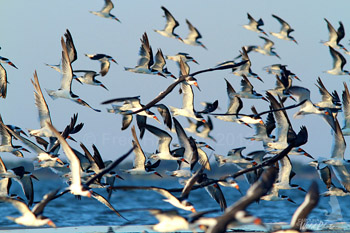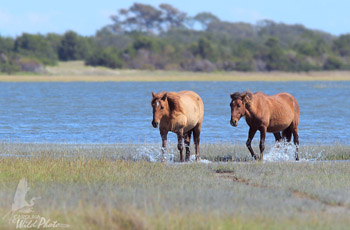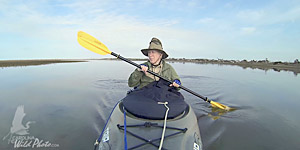I
enjoy photographing birds and wild horses, and I also like to flatwater
kayak. Getting to do all three at the same time, well...., I figured
it just could not get any better than that. However, I was wrong, because
it did get better. An opportunity came along to join photographer Bob
Decker on his mid-April Crystal
Coast Wild Horse Safari during the same week I was to be in Beaufort
to kayak and photograph at the Rachel Carson Estuarine Reserve. I jumped
on the chance like a duck on a June Bug. To top it all off, fate smiled
on us with beautiful weather, which made it all the more fantastic.
This would be my
first Spring visit to Rachel Carson Estuarine Reserve. My previous trips
were all in October and November, which is also a great time to go.
The clear air of a comfortably cool autumn day minimizes that wavy "mirage"
effect that softens your images on hotter days when shooting distant
subjects with your big telephoto lens. The species and number of birds
you'll encounter are different with different seasons too. Though I
come specifically for the wild horses, I'm not about to pass up good
opportunities for bird photos. Shooting from the low-angle, water level
view of a kayak makes for greater impact with your images. But shooting
from a kayak also has its challenges, which I'll get more into later
on.
The Rachel Carson
reserve sits just a few hundred yards across Taylor Creek along the
Beaufort waterfront. From downtown you can often see the wild horses
grazing along the edge of Town Marsh, the westernmost island of the
reserve. From the downtown waterfront it's a short paddle across for
foot exploration and photography. But when the tide is right, I prefer
paddling into the tidal marsh, accessed off Taylor Creek via a small
inlet situated roughly half way between Curtis Perry Park and the downtown
waterfront. You can reach the tidal marsh by launching from either area.
| |
 |
Leaving
Curtis Perry Park launch on Taylor Creek
|
My first day of
paddling started well before sunrise. I rose early, ate my complimentary
continental breakfast, packed my photography gear in the truck and headed
out with my brightly colored kayak trailer in tow. A bright sun peeked
over the horizon as I drove through Beaufort and reached the Curtis
Perry Park boat launch on Taylor Creek, near the east end of Lennoxville
Road. If you have a vehicle with a boat trailer, this is pretty much
your only choice in Beaufort for launching on Taylor Creek. Taking your
kayak on a car-top carrier leaves you more parking choices closer to
the downtown waterfront. My only issue with Curtis Perry Park is their
boat ramps are ribbed concrete, which does absolutely no favors for
the bottom of your kayak. Ouch!
The creek was as
smooth as glass when I launched at high tide and paddled westward up
Taylor Creek toward the inlet in the quiet stillness of a cool April
morning. Ah, what a therapeutic pleasure, so vastly different from my
usual work-a-day spent in front of three computer monitors, with only
desktop backgrounds of water, birds and wild horses to temp me.
Three quarters of
a mile up Taylor Creek I turned south into the tidal marsh, carefully
avoiding the oyster beds lurking so close to the surface. The whole
tidal marsh is littered with oyster beds that will do a nasty number
on the bottom of your kayak, or anything else that scrapes them. Depending
on the tide, this can be a real issue when paddling here. In fact,
paddling this tidal marsh requires planning, with a critical eye to
the tide tables. I learned a new lesson before this day was out, but
that comes later.
 |
| Female
Common Loon on Taylor Creek |
For the moment,
I'm paddling on glass, looking across the wide expanse of the marsh,
barely making out the tiny dots on the horizon that promise there will
be wild horses grazing ahead on Horse Island. Then I see a swimming
bird ahead. I paddle on, thinking it's the ubiquitous Cormorant. But
as I paddle closer I realize it looks more like a Loon, which I've only
ever seen in books or on TV. Loons live way up north don't they? I must
be imagining.
I stopped paddling
and let the kayak drift closer, not believing my eyes. Then I heard
that unmistakable call, three times, before it disappeared under the
water and I lost track of it. What a wonderfully unexpected surprise.
Little did I know then that I would see more Loons later in my trip.
| |
 |
| Morning
sunshine on the marsh |
As I paddle along
I begin to find bottom with the paddle easier than I expected at high
tide, but I'm getting close to Horse Island and the horses now, so I
paddle on. I really expected deeper water for some time before the tide
begins to receed. I found channels barely deep enough to pass and pressed
on, believing I had more time. Soon I was busily shooting stills and
video of the horses, and of American Oyster Catchers, Willets, White
Ibis, peeps and pipers that linger on the oyster beds still above water
as I drift past. I followed along with the horses as they waded across
channels, drifting from one grazing spot to another, nibbling on the
tempting spring growth sprouting anew.
 |
| Grazing
on the flats of Rachel Carson Estuarine Reserve |
This was quite a
new experience for me, since my previous autumn trips were when the
tide was higher, and Horse Island was underwater. I had paddled beyond
there to Bird Shoals, and even Bird Shoals was only a tiny patch of
sandbar. The horses were keeping mostly to dryer ground, so I had only
the birds out on the tidal marsh to photograph from my kayak. Paddling
among Black Skimmers swarming all around me by the hundreds had entertained
and kept me busy. I had still gotten my wild horse photos, but not from
water level in my kayak as I had hoped.
| |
 |
| Hundreds
of Black Skimmers swarm on the marsh |
This time though,
it was just as I had imagined, if not better. The horses were out in
force on the great expanse of the tidal marsh, and doing what wild horses
do - eating, running, sparring and mating. Shooting video with two cameras
and photos with two cameras while trying to keep the kayak headed in
the right direction kept me really busy. But I knew I had to take heed
of the tide.
 |
| A
Sandpiper stalking the shallows |
By now though, some
of the horses had wandered off toward Town Marsh island and the watering
hole, so I decided it was time to put the cameras away and start paddling
back toward the inlet to Taylor Creek.
Soon I found myself
backtracking, looking for the channels where I had paddled through the
maze of oyster beds. Before long I realized the water had gotten too
low, and I had to get out and pull the kayak to deeper water before
I could paddle out to Taylor Creek. Even with my weight out of the kayak
and only the weight of the gear left, it was still a chore to drag it
along, trying to avoid oyster shells, my feet slipping in the soft marsh
bottom while it sucked on my boots, trying to pull them off my feet.
Finally I reached
enough depth to paddle, so I climbed in again. It didn't last long though,
and I ended up pulling the kayak to shore on Town Marsh island. I dragged
it up above the high water mark, then farther to the shade of a cedar
tree, where I sat down and took a break to assess what I should do.
| |
 |
Hanging
out by the watering hole
|
It was a beautiful
day, not even lunch time yet, and I knew where I was because I had trekked
this area before. I was only a quarter mile from the watering hole where
I knew the horses would be, or likely feeding close by. So I grabbed
my cameras and headed out to get a few more photos. I found some of
them feeding on the grasses among the cedar trees within view of Taylor
Creek and the Beaufort waterfront. That put me to thinking of how to
get my kayak out.
 |
Heading
off the marsh to the watering hole
|
By lunch time I
had plenty of photos, and the noon light was not that good for shooting,
so I hiked back to the kayak to sit in the shade and eat my lunch. The
soft breeze and pleasant quiet, punctuated by the calls of birds flitting
about in the trees and brush, made it tempting to just sit the whole
afternoon and wait for the tide to return. But the light would be no
good for shooting for several hours, and I knew it would be approaching
sunset before the water would be high enough. I didn't want to paddle
back that late, so after lunch I did a little exploring.
Within five minutes
I found that the trees nearby were not as dense as I expected. Just
500 feet away through the trees I could see Taylor Creek, with a clear
path to the creek edge where I could put in and paddle back. All I would
have to do is drag the kayak across the grass and sand to get there.
I pondered my two options for awhile and decided dragging the kayak
to the creek was the best alternative.
| |
 |
| Paddling glassy waters |
Three trips through
the trees moved all my heavy gear close to the creek. Then I pulled
the lightened kayak to the creek and reloaded everything. Soon I was
off, paddling back to the launch ramp, only this time I had the breeze
and the tide current working with me. I mostly sat back and let nature
do the work, only paddling now and then to keep the kayak on track.
I had learned a
lesson this day, not that I hadn't already known I could be caught by
a falling tide. It was just that I hadn't realized how quickly that
could happen without noticing. It was one of those situations where
the knowledge and experience of a local guide would have saved me a
lot of work and time. But I would be all the wiser tomorrow, because
I was going to do it all over again. I could hardly wait.
|












